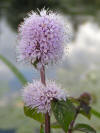WILD
FOODIES' HOME PAGE
PLANT PROFILE LIST
NAME: Watermint
SPECIES / FAMILY: Mentha Aquatica / Lamiaceae
OTHER COMMON NAME(S):
CONDITIONS:
swamps, rivers, streams, wet woods
|
PARTS: |
EDIBLE |
TASTE |
RAW/COOK |
SEASON |
|
All |
|
|
|
|
|
Shoots |
|
|
|
|
|
Leaves |
|
peppermint |
RAW/COOK |
Summer |
|
Stalk/Stem |
|
|
|
|
|
Buds |
||||
|
Flowers |
|
|
RAW |
Summer |
|
Fruits |
|
|
|
|
|
Pods |
|
|||
|
Seeds |
|
|
|
|
|
Nuts |
|
|
|
|
|
Roots |
|
|
|
|
|
Bark |
|
|
|
|
PORTION: small
COMMENT: Leaves - strong distinctive peppermint-like fragrance. Used as a flavouring in salads or cooked foods. The leaves are too pungent for most people to use as a flavouring. A herb tea is made from the leaves.(1)
CAUTION: “Although no records of toxicity have been seen for this species, large quantities of some members of this genus, especially when taken in the form of the extracted essential oil, can cause abortions so some caution is advised.”(1) Excessive mint exposure may cause an arthritic condition.
NUTRITION/MEDICINAL: Anodyne; Antidiarrhoeal; Antiseptic; Antispasmodic; Astringent; Carminative; Cholagogue; Diaphoretic; Emetic; Refrigerant; Stimulant; Stomachic; Tonic; Vasodilator.(1)
LOOK-A-LIKES: Looks like most other “upright” mints, but not groundcover/vine-like mints.
POISONOUS LOOK-A-LIKES:
OTHER USES: Repellent; Strewing. The plant repels flies, mice and rats. It has a pleasant, fresh scent and was formerly used as a strewing herb and has been strewn in granaries to keep mice and rats off the grain. The plant, harvested before flowering, yields about 0.8% essential oil. The fresh or dried plant is very good when used in herbal baths and can also be used in herb pillows.(1) Any mint is an insect and rodent repellent, just put some in a blender with water, sieve out fiber, use mint water to damp mop and dust. Also use to rinse woolen clothes to keep moths away.
SOURCE LINKS (may include nutritional and medicinal info, plus other uses):
_-_uitsnede_small.jpg)

